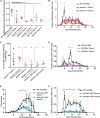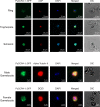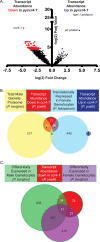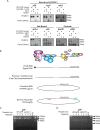Plasmodium male gametocyte development and transmission are critically regulated by the two putative deadenylases of the CAF1/CCR4/NOT complex
- PMID: 30703164
- PMCID: PMC6355032
- DOI: 10.1371/journal.ppat.1007164
Plasmodium male gametocyte development and transmission are critically regulated by the two putative deadenylases of the CAF1/CCR4/NOT complex
Abstract
With relatively few known specific transcription factors to control the abundance of specific mRNAs, Plasmodium parasites may rely more on the regulation of transcript stability and turnover to provide sufficient gene regulation. Plasmodium transmission stages impose translational repression on specific transcripts in part to accomplish this. However, few proteins are known to participate in this process, and those that are characterized primarily affect female gametocytes. We have identified and characterized Plasmodium yoelii (Py) CCR4-1, a putative deadenylase, which plays a role in the development and activation of male gametocytes, regulates the abundance of specific mRNAs in gametocytes, and ultimately increases the efficiency of host-to-vector transmission. We find that when pyccr4-1 is deleted or its protein made catalytically inactive, there is a loss in the initial coordination of male gametocyte maturation and a reduction of parasite infectivity of the mosquito. Expression of only the N-terminal CAF1 domain of the essential CAF1 deadenylase leads to a similar phenotype. Comparative RNA-seq revealed that PyCCR4-1 affects transcripts important for transmission-related functions that are associated with male or female gametocytes, some of which directly associate with the immunoprecipitated complex. Finally, circular RT-PCR of one of the bound, dysregulated transcripts showed that deletion of the pyccr4-1 gene does not result in gross changes to its UTR or poly(A) tail length. We conclude that the two putative deadenylases of the CAF1/CCR4/NOT complex play critical and intertwined roles in gametocyte maturation and transmission.
Conflict of interest statement
The authors have declared that no competing interests exist.
Figures






Similar articles
-
Plasmodium falciparum Calcium-Dependent Protein Kinase 4 is Critical for Male Gametogenesis and Transmission to the Mosquito Vector.mBio. 2021 Dec 21;12(6):e0257521. doi: 10.1128/mBio.02575-21. Epub 2021 Nov 2. mBio. 2021. PMID: 34724830 Free PMC article.
-
Changes in the transcriptome of the malaria parasite Plasmodium falciparum during the initial phase of transmission from the human to the mosquito.BMC Genomics. 2013 Apr 15;14:256. doi: 10.1186/1471-2164-14-256. BMC Genomics. 2013. PMID: 23586929 Free PMC article.
-
Transcriptional Profiling Defines Histone Acetylation as a Regulator of Gene Expression during Human-to-Mosquito Transmission of the Malaria Parasite Plasmodium falciparum.Front Cell Infect Microbiol. 2017 Jul 24;7:320. doi: 10.3389/fcimb.2017.00320. eCollection 2017. Front Cell Infect Microbiol. 2017. PMID: 28791254 Free PMC article.
-
Crystal structure and functional properties of the human CCR4-CAF1 deadenylase complex.Nucleic Acids Res. 2021 Jun 21;49(11):6489-6510. doi: 10.1093/nar/gkab414. Nucleic Acids Res. 2021. PMID: 34038562 Free PMC article.
-
The Plasmodium NOT1-G paralogue is an essential regulator of sexual stage maturation and parasite transmission.PLoS Biol. 2021 Oct 21;19(10):e3001434. doi: 10.1371/journal.pbio.3001434. eCollection 2021 Oct. PLoS Biol. 2021. PMID: 34673764 Free PMC article.
Cited by
-
Identification of basal complex protein that is essential for maturation of transmission-stage malaria parasites.Proc Natl Acad Sci U S A. 2022 Aug 23;119(34):e2204167119. doi: 10.1073/pnas.2204167119. Epub 2022 Aug 16. Proc Natl Acad Sci U S A. 2022. PMID: 35972967 Free PMC article.
-
Phenotypic Screens Identify Genetic Factors Associated with Gametocyte Development in the Human Malaria Parasite Plasmodium falciparum.Microbiol Spectr. 2023 Jun 15;11(3):e0416422. doi: 10.1128/spectrum.04164-22. Epub 2023 May 8. Microbiol Spectr. 2023. PMID: 37154686 Free PMC article.
-
Adapt or Die: Targeting Unique Transmission-Stage Biology for Malaria Elimination.Front Cell Infect Microbiol. 2022 Jun 9;12:901971. doi: 10.3389/fcimb.2022.901971. eCollection 2022. Front Cell Infect Microbiol. 2022. PMID: 35755845 Free PMC article. Review.
-
New insights into the evolution of CAF1 family and utilization of TaCAF1Ia1 specificity to reveal the origin of the maternal progenitor for common wheat.J Adv Res. 2022 Dec;42:135-148. doi: 10.1016/j.jare.2022.04.003. Epub 2022 Apr 13. J Adv Res. 2022. PMID: 36513409 Free PMC article.
-
Widespread release of translational repression across Plasmodium's host-to-vector transmission event.PLoS Pathog. 2025 Jan 8;21(1):e1012823. doi: 10.1371/journal.ppat.1012823. eCollection 2025 Jan. PLoS Pathog. 2025. PMID: 39777415 Free PMC article.
References
-
- World Malaria Report: World Health Organization.; 2017. Available from: http://apps.who.int/iris/bitstream/handle/10665/259492/9789241565523-eng....
-
- Rosenberg R, Wirtz RA, Schneider I, Burge R. An estimation of the number of malaria sporozoites ejected by a feeding mosquito. Trans R Soc Trop Med Hyg. 1990;84(2):209–12. . - PubMed
Publication types
MeSH terms
Substances
Grants and funding
LinkOut - more resources
Full Text Sources
Molecular Biology Databases

